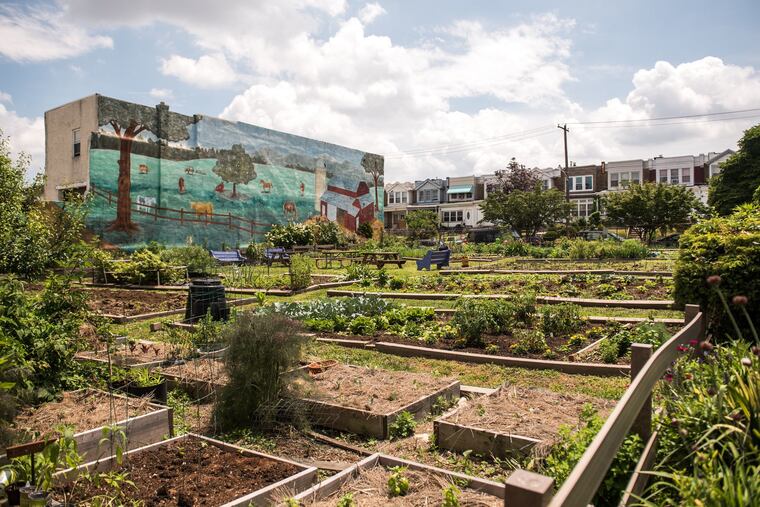What vegetables to plant for a fall harvest in Philadelphia
It’s not too late to plan for a fruitful fall harvest. Here are the vegetables you can plant in late summer, and eat in the fall.

It’s peak summer harvesting season. And for my fellow gardeners, that hopefully means you’re hands-deep in all the ingredients of a delicious spaghetti sauce: Tomatoes, basil, perhaps summer squash, peppers, and eggplant, too. Evenings are spent picking. And ideally your kitchen feels even busier.
With all of summer’s glory, it’s natural to feel preoccupied right now. (Not to mention, there’s a pandemic to think about, too.) But consider pausing to look forward.
Early-season crops are well past their prime, which means you may have room to spare in your garden. What should you do with those empty spaces? Fill them with seeds and starters, of course. It’s not too late to plan for a fruitful fall harvest.
“You can have food out of the garden every month of the year in this climate; it’s just about timing,” says Glenn Brendle, who founded Green Meadow Farm in Lancaster County with his wife.
When choosing what to plant, look for produce with a short to moderate growth window.
“We still have August, September, and most of October — so around 70 days of growing season in a bad year, and 80 or 90 days in a good year, until frost sets in,” says Brendle. “You can think of fall like spring in reverse. Anything that you’d plant after the last frost in spring that would mature in early June could be planted now for fall.”
Here’s what to consider sowing in mid-August.
GROW NOW
Brassicas
Cabbage, cauliflower, broccoli, and Brussels sprouts are all fair game for a mid-August planting.
“By seed, you’re taking a bit of a chance, so the safest way is to get starters from the garden shop,” says Brendle.
Broccoli and cauliflower are sensitive to frost, so in the event of an early cold spell, cover them to save any growing crowns.
Radishes
Whether you missed them in the spring or want to go in for round two, radishes are one of the fastest growing crops. It takes just about four weeks from seed to harvest. Stagger your plantings to reap multiple pickings throughout fall.
Peas
Snow peas, snap peas, and English peas can all be started from seed right now. They’ll be ready to pick right around the first frost — the ideal time for a pea harvest.
“This will make them exceptionally sweet,” says Brendle. “As the weather gets cold, the plants produce more sugar because sugar is like antifreeze. It doesn’t freeze, and so it protects the plants against frost.”
You can also try your hand at planting peas in mid-September, letting them battle it out through the winter for an early spring harvest.
“They can survive the cold temps, and then come spring, you’ll be the marvel of your neighborhood,” says Brendle.
Green beans
Green beans can reach full maturation in as little as 50 to 55 days. Pole beans typically take a bit longer, but Brendle recommends bush beans regardless since they don’t require trellising, making them slightly lower maintenance.
“There’s a variety called Strike that are absolutely wonderful,” says Brendle. “They’re a nice, long straight bean, totally stringless, and delicious at every size.”
Beets
Beets require up to 65 days to reach full maturity and can weather through a light frost.
“Even if you’re a little late, you can still get some nice young ones,” says Brendle.
And you can harvest the beet greens even before the beet roots are ready. The leaves produce needed energy, so limit your picking to one to two per plant while the roots are still developing. Cook the greens just as you would Swiss chard, for an earthy, tender treat.
PLAN AHEAD
Greens
Greens, like kale, collards, and lettuce loathe hot weather. Yes, your spring Lacinato leaves might still be standing, but cook them up right now, and each bite will be bitter.
“They need the cold weather to sweeten them up,” says Brendle.
Wait until it gets cooler — around late August — to plant outside. In the meantime, you can sow seeds indoors, filling a flat of seed trays to be placed on your window or under a grow light. Once the sprouts reach three to four inches tall, they’re ready to be transplanted. You can also purchase and plant starters as late as September.
Garlic
The key to growing garlic in this region is to start several seasons in advance. Plant it in late fall, and come spring, your garlic cloves will send up shoots. By mid-July, it’ll be ready to harvest.
“If it’s warm, you’ll plant it as late as November because you don’t want too much growth before winter,” says Brendle.
Cover crops
Once your fall harvest winds down, you may want to think about cover crops. Cover crops are grown in the off-season to replenish nutrients and improve soil fertility. There are a variety of options, mostly grasses and legumes, which are typically planted in September or October. Remove all that’s left in your garden, and these will take over for the winter.
If you want a two-for-one, Brendle recommends growing rapeseed, which will not only restore your soil, but tastes good, too.
“It’s cheap, and you can eat the young leaves, and also harvest the heads and eat it like broccoli rabe,” says Brendle.
» READ MORE: More Philly tips: Read our most useful stories